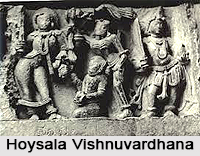 The Hoysala dynasty of ancient Karnataka which was in power from the 11th-14th centuries A.D., had contributed substantially to the glorious history and culture of Karnataka and to South India as a whole. Among the glorious rulers of Hoysala dynasty, Vishnuvardhana held a very prominent position as he is credited for expanding a small principality into a very huge empire. He was initially the governor of the territory named Gangavadi when his brother Ballala I was the king and came to power on the death of the latter in 1108 A.D. Vishnuvardhana led many successful military expeditions into the areas of the Nolambas and the Gangas (of south Karnataka) who were important powers at that point of time and also succeeded in evicting the mighty Cholas from Karnataka, thus spreading the Hoysala power over major portions of Karnataka.
The Hoysala dynasty of ancient Karnataka which was in power from the 11th-14th centuries A.D., had contributed substantially to the glorious history and culture of Karnataka and to South India as a whole. Among the glorious rulers of Hoysala dynasty, Vishnuvardhana held a very prominent position as he is credited for expanding a small principality into a very huge empire. He was initially the governor of the territory named Gangavadi when his brother Ballala I was the king and came to power on the death of the latter in 1108 A.D. Vishnuvardhana led many successful military expeditions into the areas of the Nolambas and the Gangas (of south Karnataka) who were important powers at that point of time and also succeeded in evicting the mighty Cholas from Karnataka, thus spreading the Hoysala power over major portions of Karnataka.
Vishnuvardhana was greatly influenced by the teachings of Ramanuja, the eminent Sri Vaishnava preceptor and philosopher who was staying in the Mysore at that time and thus embraced Vaishnavism. He constructed the outstandingly stunning and ornate Chenna Kesava (Vishnu) temple at Belur during his reign in 1117 A.D. by the master architects Dasoja and his son Chavana. Many other temples such as the Kirti Narayana shrine at Talakkad were also constructed during his reign when great impetus was given to temple architecture.
This king respected all faiths. During his reign, Buddhism and Jainism flourished alongside Vaishnavism and Saivism. Jainism in particular was a predominant faith during this time and there were many renowned Jaina teachers and philosophers in his kingdom. A number of famous literary works by renowned poets like Rajaditya were composed during his reign. That the Kalamukhas (a sect of Saivas, known for several gruesome practices) were prominent in the Hoysala kingdom (as they were in several other places in South India at that time) is seen from inscriptional evidence.
Among Vishnuvardhana`s queens, the most famous was Shantala Devi, a celebrated beauty and renowned dancer who was a Jain by faith. He was succeeded by his son Narasimha who was unfortunately a weak ruler with the result that the Hoysala Empire shrunk in size.



















